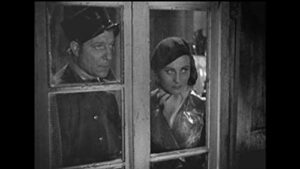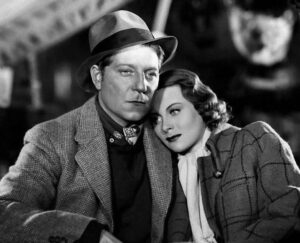“Port of Shadows” – Marcel Carné’s Poetic Work

Title: “Port of Shadows”
Release Date: 1938
Director: Marcel Carné
Cast: Jean Gabin, Michéle Morgan, Michel Simon, Pierre Brasseur, Edouard Delmont
“Port of Shadows” by Marcel Carné is one of the first films of French poetic realism. Although the name is not entirely accurate, the works marking this trend are characterized by a combination of the image of social lowlands with a depressive, somewhat mysterious atmosphere and an important role of poetic symbols. The latter are in “Port of Shadows” an unquestionable merit of Jacques Prevert, the great poet and screenwriter Marcel Carné. In a fatalistic story about the inevitability of destiny and love doomed to failure, the leading roles are played by the legendary Jean Gabin and the budding Michéle Morgan.
“Port of Shadows” – a story with a sad finale
The script of “Port of Shadows” was inspired by Pierre Mac Orlan’s novel. The main character of the movie is Jean (Jean Gabin), a deserter from the French colonial army, who arrives in the port city of Le Havre, from where he hopes to get on a ship and escape the country. He is accompanied by a stray mongrel he meets on the way. The man accidentally finds lodging in the “Panama” pub, where he meets peculiar people: among them the painter-decadent Krauss (Robert Le Vigan), a man from the criminal underworld Lucien (Pierre Brasseur), a wealthy store owner Zabel (Michel Simon) and a beautiful girl named Nelly (Michéle Morgan).
Jean almost immediately falls in love with the young woman and rescues her from oppression – lurking Lucien, and then learns her sad fate. Nelly is almost imprisoned by her jealous and repulsive uncle Zabel, who murders the girl’s fiancé. Soon Jean, with the help of a port doctor and documents from Krauss, wins a place on a ship to Venezuela. He spends his last night with Nelly, promising her an imminent reunion. Just before the ship departs, Jean returns to hug his beloved again. He finds her with her wicked uncle, whom he kills in a fit of anger. As he leaves Nelly’s apartment, Lucien, who was insulted by him earlier, fires fatal shots at the hero. The ship sails away, and in the harbor Nelly weeps over the corpse of her beloved. A stray dog senses his friend’s death and flees the city.

“Port of Shadows” and black poetic realism
“Port of Shadows” is often pointed to as the first film of the French film trend called black poetic realism. This direction originated in French literature, and Marcel Carné became its most important representative in cinema. The director most often collaborated with the poet Jacques Prevert, who created magnificent scripts saturated with rich symbolism. However, the term “realism” in the case of films of the late 1930s is quite misleading. It refers primarily to the type of characters portrayed: simple people – representatives of the proletariat. Nevertheless, apart from the location of the plot in this environment, this trend has little to do with realism – as it does not analyze any social problems, such as poverty, lack of prospects or daily worries of working people. The characters use a specific, sophisticated language and are marked by an aura of pessimism. More can be seen in them personifications of certain ideas than flesh-and-blood characters.
Nevertheless, “Port of Shadows” as one of the finest examples of black poetic realism is a cinematic masterpiece. Every detail here is perfectly fine-tuned. Starting from the symbolic setting of the foggy port city imbued with a growing aura of anxiety and danger, through the excellent cinematography reminiscent of Josef von Sternberg’s films, to the creation of characters and dialogues saturated with the fatalism of fate – everything creates a perfect whole. The author of the realistic decorations was Alexander Trauner, while the phenomenal cinematography, mostly at night, was taken by Eugen Schufftan. “Port of Shadows” captures the climate of the decline of an era: just before the catastrophe of World War II, which is about to wipe this old world off the face of the earth.
Jean Gabin and Michéle Morgan – proletarian amant and femme fatale
The charm of “Port of Shadows” is due in large part to the well-written characters and sensational acting. Jean Gabin, thanks to the films of Marcel Carné, was created as a romantic lead stemming from the people. He became the embodiment of a masculine, strong character shying away from effusiveness, but at the same time sensitive to other people’s suffering. In the film, not coincidentally, Jean takes in a stray dog and sees the drama of Nelly. At the same time, he is a man with an extremely pessimistic disposition, somehow aware of the inevitable disaster awaiting him. Despite this tragic premonition, Jean gets involved in a relationship with a fatal woman – Nelly, attracting trouble herself. And indeed this relationship leads the protagonist to death.

Only 18-year-old Michéle Morgan brilliantly created the character of a young girl enslaved by her evil uncle, who seeks escape from him in dangerous nocturnal escapades and relationships with men. From the first moments when the heroine appears on the screen, she almost magnetizes the viewer. In the original costume designed by Coco Chanel: a reflective raincoat and beret, she almost makes the impression of a character from another world – an innocent being lost in the epicenter of an evil, cruel reality. The role of the delicate Nelly, who brings men bad luck, opened Morgan’s career door and made her name in cinema history.
Why “Port of Shadows”
In “Port of Shadows” there are many elements saturated with symbolism, such as a stray dog, the motif of escape, closed interiors, labyrinthine streets and the prevailing night time. Most significant, however, is the fog present in the title, recurring in the setting and in the dialogues of the characters. Jean arriving in Le Havre says: “There is only fog around. Empty somehow.” The foggy city in the film has a parabolic character, becoming a model of a world that is not safe, but forces people to constantly flee and seek shelter. The fog disrupts cognitive abilities and becomes synonymous with confusion and uncertainty. It also reinforces feelings of danger and isolation from others. Pessimism, loneliness and the search for a way out dominate. The latter, however, is unattainable. This is because an atmosphere of fatalism dominates over everything – the dream ship to another world sails away without the protagonist, giving rise to very bad premonitions.
Literature:
G. Stachówna, „100 melodramatów. Leksykon”, Kraków 2000.
„Kino klasyczne”, pod red. T. Lubelskiego, I. Sowińskiej i R. Syski, Kraków 2012.

